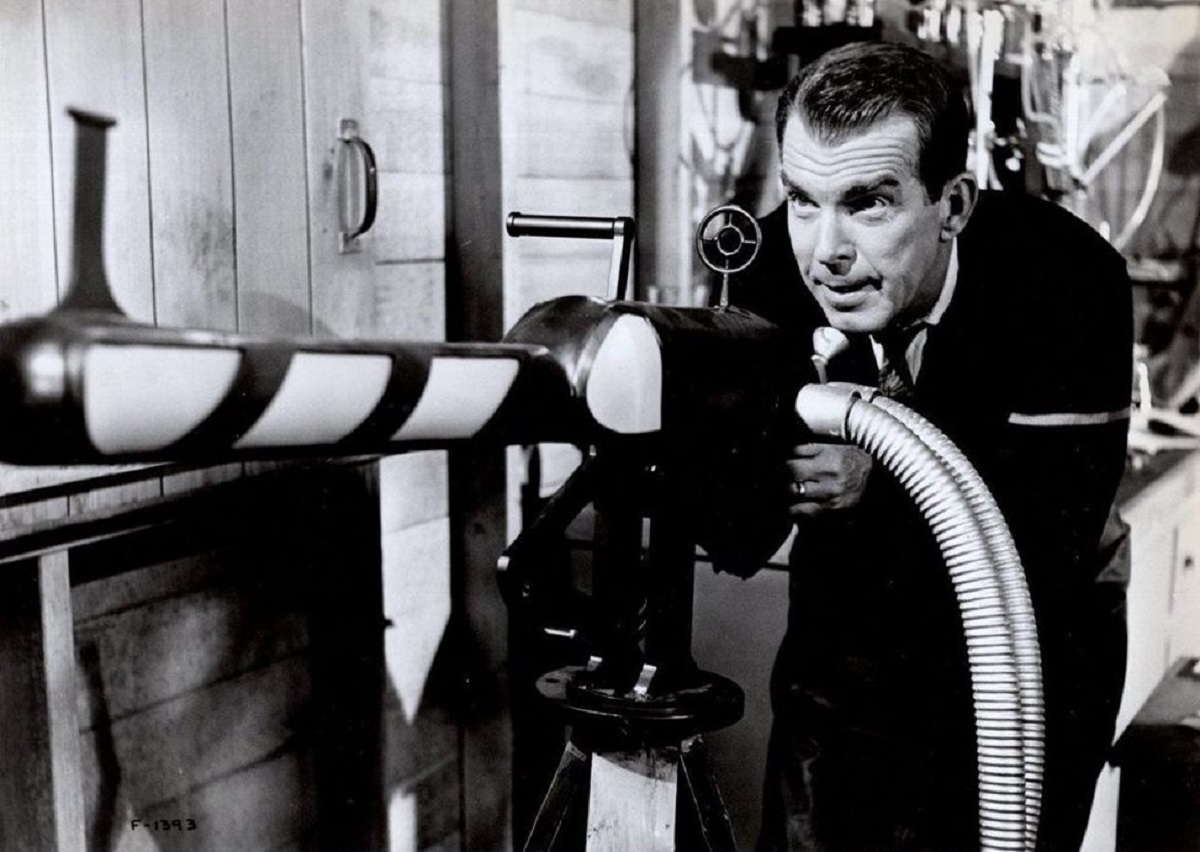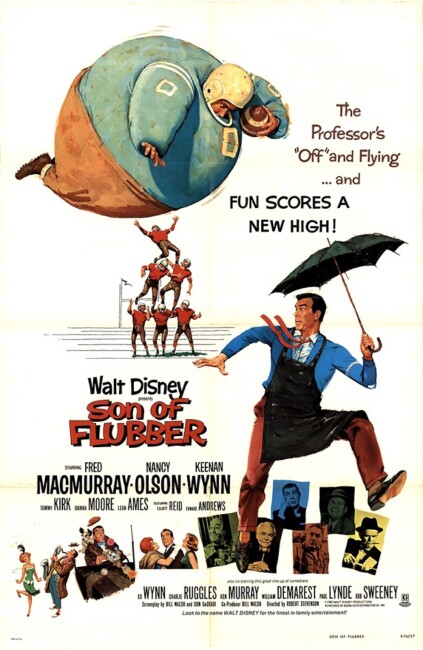Crew
Director – Robert Stevenson, Screenplay – Don DaGradi & Bill Walsh, Based on the Danny Dunn Books by Raymond Abrashkin & Jay Williams, Producers – Don DaGradi & Ron Miller, Photography (b&w) – Edward Colman, Music – George Bruns, Special Effects – Jack Boyd, Jim Fetherolf, Eustace Lycett & Robert A. Mattey, Makeup – Pat McNalley, Art Direction – Carroll Clark & William H. Tuntke. Production Company – Disney.
Cast
Fred MacMurray (Professor Ned Brainard), Nancy Olson (Betsy Brainard), Tommy Kirk (Biff Hawk), Keenan Wynn (Alonzo Hawk), Elliott Reed (Shelby Ashton), Joanna Moore (Desiree de la Roche/Mary Lee Spooner), Leon Tyler (Humphrey Hacker)
Plot
Professor Ned Brainard is disappointed when the military delay giving appropriations for him to develop Flubber. He returns home to Betsy who is facing mounting bills. Ned places his hopes in perfecting Flubbergas, a gaseous form of Flubber that can create storms out of nothing – although one of the unforeseen side effects is that the Flubbergas shatters all the glass in town. Upon discovering that this was caused by the Flubbergas, Alonzo Hawk seeks to blackmail Ned and comes up with a scheme to buy up stock in a glass company and then use the Flubbergass to keep shattering windows. Meanwhile, Betsy leaves Ned, believing he has taken up with an old flame. Once again, Hawk is about to foreclose on Medfield College. The Medfield football team are losing, requiring an ingenious facilitation on Ned’s part by injecting the balls and players with Flubbergas.
Son of Flubber is a sequel to The Absent-Minded Professor (1961). The Absent-Minded Professor was a substantial hit for Disney and the start of the dizzy live-action comedies they would specialise in throughout the 1960s and 70s. Son of Flubber reunites most of the personnel behind The Absent-Minded Professor – director Robert Stevenson, screenwriter Bill Walsh, and stars Fred MacMurray, Nancy Olson, Keenan Wynn, Tommy Kirk and Elliott Reed. Son of Flubber is the only sequel to The Absent-Minded Professor that Disney would make, although the original was remade twice in the ensuing decades as the tv movie The Absent-Minded Professor (1994) and the cinematically released Flubber (1997).
Son of Flubber falls into the all-too-common problems that most sequels do. It is heavily reliant on elements from the first film – a villainous Alonzo Hawk about to foreclose on the university, Betsy walking out on Ned, Ned’s rival for Betsy’s affections in Shelby, the comic-relief cops, flying sports teams. Indeed, the constant recycling of elements from the first film has a repetitiveness that verges on the drearily unimaginative.
Fred MacMurray gives another likeable, straight-faced donkeyish performance but the inspiredly bouncy, daffy sense of fun behind the first film is absent. There is the odd sparkle – images of Flubberised babies bouncing around rooms, or a nice line in satire from Bob Sweeney as a tax man checking up on paperboys who proudly talks about having turned in his own mother for undeclared income on jam jar sales.

The plot for Son of Flubber has been loosely taken from Danny Dunn and the Weather Machine (1959), one of a popular series of juvenile novels of the 1950s and 60s by Raymond Abrashkin and Jay Williams concerning a teenager involved in a series of science-related escapades. The title is a puzzle in that neither Fred MacMurray, nor for that matter the flubber, have any children anywhere throughout the film.
British director Robert Stevenson made a number of other films for Disney that include Disney include Darby O’Gill and the Little People (1959), The Absent-Minded Professor (1961), In Search of the Castaways (1962), The Misadventures of Merlin Jones (1963), Mary Poppins (1964), The Monkey’s Uncle (1965), The Gnome-Mobile (1967), Blackbeard’s Ghost (1968), The Love Bug (1969), Bedknobs and Broomsticks (1971), Herbie Rides Again (1974), The Island at the Top of the World (1974) and The Shaggy D.A. (1976). Before moving to Hollywood, Stevenson also made the Boris Karloff mad scientist film The Man Who Changed His Mind (1936) and the sf film Non Stop New York (1937).
Trailer here

